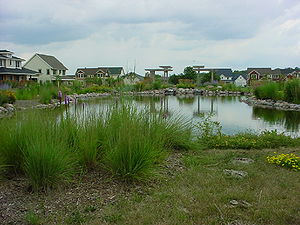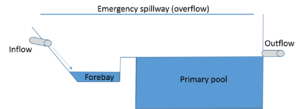
This fact sheet focuses on stormwater wet ponds. These are constructed ponds designed to capture stormwater runoff from impervious surfaces (e.g. streets, sidewalks, roofs). Wet ponds help mitigate flooding and improve water quality in urban areas.
Contents
What is a stormwater wet pond?
Urban areas contain roads, sidewalks, roofs and other hard surfaces that are impermeable to water. When rain falls or snow melts on these impervious surfaces, the water drains to storm sewers and eventually to lakes and rivers. Water that drains off impervious surfaces is called stormwater runoff.
Large storm events contribute large volumes of runoff moving at an increased rate, which raises the potential for erosion and flooding downstream. Stormwater runoff also contains pollutants that it picks up from the impervious surfaces, such as sediment, oil, salt, and nutrients associated with fertilizer and plant material such as grass and leaves. These pollutants can contaminate lakes and rivers. To reduce these negative impacts, stormwater professionals can implement several practices, such as rain gardens, permeable pavement, and green roofs. One of the most important practices is to retain stormwater runoff in a constructed basin or pond. Water is held in the pond for a period of time, allowing sediment to settle out and releasing the water over days instead of hours, which relieves flooding downstream. The most common type of pond is a wet pond, which has a permanent pool of water throughout the year. This pool of water allows for sediment and pollutants associated with that sediment to settle and remain in the wet pond, where they can later be removed and properly disposed.
How does a stormwater wet pond work?
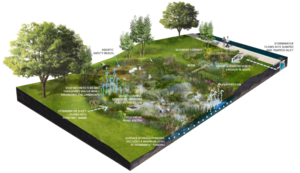
The schematic at the right illustrates how stormwater wet ponds work. Water from impermeable surfaces drains to a wet pond. Most wet ponds have a forebay, a small pool of water that absorbs the energy of the incoming water and allows sediment to settle. Water flows from the forebay to a second pool, where additional settling occurs. The water level in this second pool, called the primary pool, is controlled by an outlet structure. If the water level exceeds the outlet elevation, such as after a heavy rainfall, the water is slowly released through the outlet structure. This diminishes the likelihood of downstream flooding, since the water is being slowly released downstream rather than accumulating all at once during the rainfall. In the case of extreme rain events, water may flow over the highest elevation (embankment), called the emergency spillway or overflow, in the pond.
Most ponds have some vegetation. Wetland vegetation occurs in places where the plants are always inundated with water. Plants growing in other locations within the pond must be tolerant of short periods of inundation, similar to plants grown in rain gardens.
A stormwater pond isn't a natural pond or wetland
Stormwater wet ponds may look like a wetland. They often have wetland vegetation and some wetland wildlife. They are not natural water bodies, however, and should not be treated as such. The main differences between natural water bodies and constructed ponds include the following.
- Water levels can change by several feet in constructed ponds, whereas most natural water bodies have fairly constant water levels.
- Constructed ponds are built to capture sediment that is in runoff. Sediment may therefore accumulate quickly in the pond. This sediment also may contain pollutants that are attached to the sediment.
- Constructed ponds must be maintained and properly managed.
Stormwater wet ponds are not intended and should not be used for recreational purposes. Although they can be aesthetically pleasing, they should not be managed for aesthetic purposes if this interferes with their primary function, which is to capture, retain, and treat stormwater runoff. For example, it is generally not appropriate to introduce fish to wet ponds as the fish may decrease the treatment effectiveness of the pond.
Who builds, owns, and is responsible for wet ponds?
Wet ponds are typically constructed as part of a new urban development or redevelopment project. Often a construction stormwater permit is required for these projects. These permits have requirements for how stormwater must be managed once the project is completed. Developers typically bear the cost of constructing the wet pond. Developers contract with engineering firms that are qualified to design and construct wet ponds. Once the project is complete, ownership of the pond most often transfers to a homeowners association or to a local government unit.
The owner is responsible for maintaining the pond once it is constructed. The owner may conduct some of the routine maintenance, such as mowing and trash removal. More often the owner will complete an agreement with a maintenance team or landscaping contractor to conduct frequent inspection and maintenance items such as mowing, checking for clogs, and debris removal (link to example maintenance agreements).
The owner of the pond bears financial responsibility for maintaining the pond and implementing repairs if they are needed. This Minnesota Stormwater Manual provides some information on costs of maintaining ponds, but the cost information is highly variable. Estimated annual operation and maintenance costs for wet basins are 3 percent to 5 percent of construction costs. Mowing and sediment removal are the most costly activities. Responsible parties should establish a maintenance fund and assess annual fees on appropriate property/home owners. Local governments can establish stormwater utilities or charge inspection fees to carry out their maintenance responsibilities.
How effective are wet ponds?
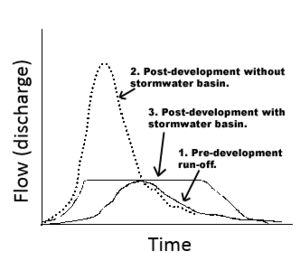
The effectiveness of a stormwater wet pond depends on several factors. Some general guidelines include the following.
- Properly sized and constructed ponds are very effective at controlling the rate of water discharged downstream.
- In properly designed and constructed ponds, most of the sediment trapping will occur in the forebay and the primary pool will not undergo scouring as water flows into it. Well constructed wet ponds can capture about 85 percent of incoming sediment and about 60 percent of incoming phosphorus. Very fine particles (e.g. clay particles) and phosphorus not attached to sediment will not be captured and will be discharged from the pond, where they may pollute downstream waters.
- Pond effectiveness typically decreases over time as the pools fill up with sediment.
- Ponds must be properly maintained or their effectiveness decreases.
How should stormwater wet ponds be managed?
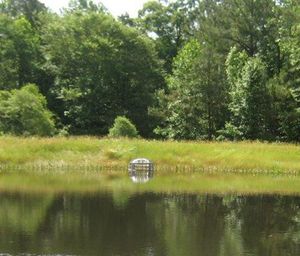
Routine and long-term maintenance of stormwater wet ponds is essential to continue effectively removing pollutants. Maintenance includes the following.
- Monthly to quarterly, after major storms, or as needed
- Remove sediment and trash from the pond inlets and outlets
- Remove trash from trash rack (see image at right)
- Along embankments, keep vegetation at heights that allow inspection for animal burrows, sinkholes, wet areas, etc. Common mistakes are not mowing important areas because they are too steep or ignoring mowing completely. The amount of maintenance depends on the type of vegetation surrounding the basin. Some grasses need weekly mowing, and others can be maintained a couple of times a year.
- Repair undercut, eroded, bare soil areas, and gullies in the bank
- Semi-annually to annually, or as needed
- Conduct shoreline cleanup to remove trash, debris and floatables
- Open up the riser to access and test the valves (see image at right)
- Repair broken mechanical components, such as pumps, if needed
- Non-routine maintenance
- Remove sediment from the forebay every 5 to 7 years or after 50 percent of total forebay capacity has been lost.
- Sediment removal in the primary pool should occur approximately every 25 years or after 50 percent of the pool capacity has been reached.
Additional maintenance guidelines include the following.
- Repair of structural components is required immediately if they impair the functionality of the pond.
- Mowing of the pond buffer not located along maintenance rights-of-way and the embankment can be managed as a meadow (mowing every other year), prairie, or forest.
- Ponds may be drained in an attempt to improve their functionality or conduct repairs. Ponds should not be drained during the spring, as temperature stratification and high chloride concentrations at the bottom can occur, which could result in negative downstream effects. Care should be exercised while draining the pond to prevent rapid release and minimize the discharge of sediments or anoxic water. The owner should work with the approving jurisdiction should be notified before draining a pond.
Useful links
Below are Internet links to additional information.
- Plants for stormwater design
- Stormwater pond design, construction, maintenance (technical information)
- Pond Maintenance - a very useful non-technical site
- Wet and dry stormwater ponds - another useful non-technical site
- Stormwater wet pond and wetland management guidebook - an extensive guidebook from EPA discussing all aspects of wet ponds
Related links
- Overview for stormwater ponds
- Types of stormwater ponds
- Design criteria for stormwater ponds
- Design considerations for constructed stormwater ponds used for harvest and irrigation use/reuse
- Construction specifications for stormwater ponds
- Assessing the performance of stormwater ponds
- Operation and maintenance of stormwater ponds
- Cost-benefit considerations for stormwater ponds
- Calculating credits for stormwater ponds
- Stormwater wet pond fact sheet
- References for stormwater ponds
- Requirements, recommendations and information for using stormwater pond as a BMP in the MIDS calculator
